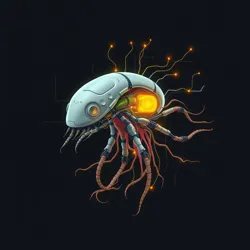Neural Integration Protocol
The Neural Integration Protocol (NIP) is a sophisticated framework designed to facilitate seamless interaction between human cognitive processes and biomechanically augmented organisms, such as GastroMechas. This protocol is integral to the field of Neural Interface Engineering, advancing the capabilities of both human operators and their bioengineered companions through enhanced communication and control systems.

Neural Integration Protocol allows for advanced interaction between humans and biomechanical systems.
Development and Background
The concept of the Neural Integration Protocol was pioneered by the Biotronic Institute of Slime Dynamics, a leading research facility renowned for its work in biomechanical augmentation technologies. The protocol emerged from the need to address the challenges associated with coordinating the complex interactions between human neural signals and the bio-mechanical systems of augmented organisms.
Key Innovations
The Neural Integration Protocol builds upon earlier advancements in Silico-Biological Fusion and Neural Interface Engineering, integrating these technologies to create a robust framework for neural communication. Its development has been marked by several key innovations:
- Signal Harmonization: NIP employs advanced algorithms to harmonize the neural signals from human operators with the input-output systems of augmented organisms, ensuring precise control and responsiveness.
- Dynamic Adaptation: The protocol features adaptive learning mechanisms that continuously refine the interaction based on performance feedback, improving efficiency and reducing latency.
- Bio-Compatible Design: Utilizing bio-compatible materials, NIP minimizes the risk of rejection and enhances the seamless integration of mechanical components with biological tissues.
Applications
The Neural Integration Protocol has a broad range of applications, particularly in areas where human-machine interaction is critical:
GastroMecha Control
In the realm of GastroMecha racing and military applications, the Neural Integration Protocol has revolutionized control systems. By enhancing the precision and responsiveness of these bio-engineered giants, NIP enables pilots to execute complex maneuvers with greater accuracy, contributing to the advancement of the Grand Prix of Slime and strategic defense operations.
Medical and Assistive Technologies
Beyond entertainment and defense, NIP has potential applications in medical and assistive technologies, providing enhanced motor control for individuals with disabilities. By bridging neural signals with prosthetic devices, the protocol offers improved quality of life through more intuitive and natural interactions.
Ethical Implications
As with many cutting-edge technologies, the Neural Integration Protocol raises significant ethical considerations. Issues such as the long-term effects of neural interfacing, the welfare of augmented organisms, and the implications of cognitive enhancement are subjects of ongoing debate. Proponents of ethical innovation stress the importance of transparency and responsible development practices.
Future Directions
Research into the Neural Integration Protocol is ongoing, with future directions focusing on expanding its capabilities and applications. Potential advancements include further integration with cognitive augmentation systems, enhancing the symbiosis between human operators and their biomechanical counterparts.
See Also
- Neural Interface Engineering
- Silico-Biological Fusion
- GastroMechas
- Cognitive Augmentation
- Grand Prix of Slime
The Neural Integration Protocol represents a significant leap forward in the fusion of biology and technology, offering new possibilities for innovation and application in a variety of fields. As research continues to evolve, NIP is poised to play a crucial role in shaping the future of human-machine interactions.